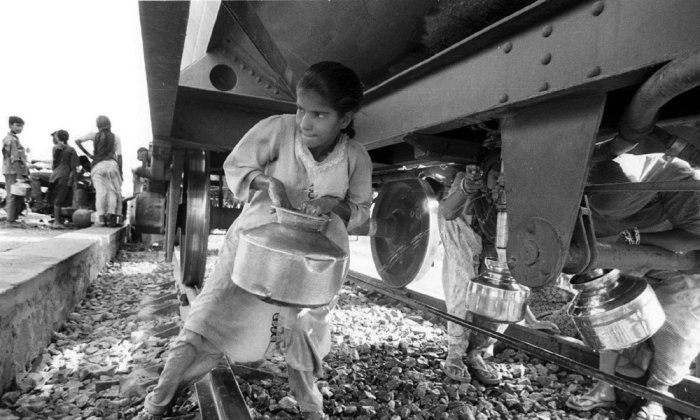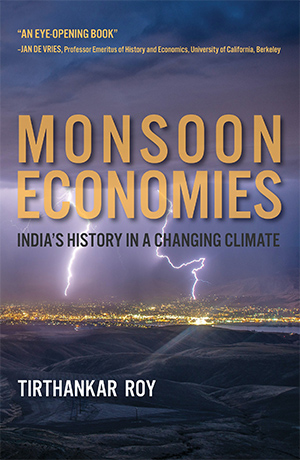‘Annihilation of Caste’ and the Struggle for Water Equality

Less than a century ago, the distribution of water in India was status-based. Access to water was segregated and unequal between families and communities. The private rights to secure supplies were guarded in the name of ritual purity. Famine relief operations in the late 19th century, following a devastating drought, led to the construction of wells and changed distribution to some extent. Yet, the status-based right was embedded in practices and beliefs that the state could not reach and did not want to touch. The relief operation alone could not weaken the force of custom. Famine documents did, however, expose how deadly tradition had been during natural disasters. That knowledge was public when a struggle to wrest “the right to draw water from a common well” emerged early in the interwar years. Western India, where the memory of the famines was still fresh, was the stage. In the following excerpt from “Monsoon Economies: India’s History in a Changing Climate,” economic historian Tirthankar Roy charts that struggle.
In 1914, Hiraman Dhondi Mochi drew water from a sacred lake affiliated to a temple near Bombay. A leatherworker and an untouchable, Mochi had concealed his caste identity when using the lake and posed as a fruit seller. When Mochi was found out, the temple authority sued him for having defiled the water. Insult to religion was an offense under penal law. The magistrate ordered a prison sentence. But the case went to appeal and settled in Mochi’s favor. The appellate court made a distinction between drawing water and intentional disrespect to religion, observing that if the two things conflated, all rivers would be inaccessible to most Indians.

Whether as an effect of the judgment or the expansion of local self-government, in the following decade, in many villages of western India, groups would try to take control of a pool held sacred by the upper castes. These cases did not end in violence or a court case but more often ended with arbitration of some sort. In a 1924 incident at the central Maharashtra temple town Lonar, the attempt by a “band of 500 untouchables” to “pollute the sacred stream” failed, reported the Times of India, because the “Deputy Commissioner [had] threatened the depressed classes with instantaneous arrests in case they repeated their attempts.” A 1931 movement to open access to a well failed because of a dispute among the depressed caste groups. Caste set a moving target. “Within the ranks of ‘untouchables,’” another newspaper report on a 1925 dispute said, “there are grades of untouchability, and where this is the case the higher grades will not drink from the wells of the lower grades.”
In a Karnatak village, a political activist persuaded the upper castes to open access to the deprived castes, on condition that the latter would give up eating meat and drinking alcohol.
A yet third type of outcome was outsider arbitration, which was becoming more frequent in western India because M. K. Gandhi and social reformer Bhimrao Ramji Ambedkar tried to bring the depressed castes into the political mainstream, with different arguments. In a Karnatak village, a political activist persuaded the upper castes to open access to the deprived castes, on condition that the latter would give up eating meat and drinking alcohol. Ambedkar’s seminal 1936 book “Annihilation of Caste” documents many more cases of local protest. Newspapers in the cities also recorded and discussed numerous instances wherein secure water, so far a private and community good guarded in the name of a shared social value, became a target of capture.
The most organized of the movements occurred in the small town of Mahad, 100 miles south of Bombay, in 1927. A group led by Ambedkar tried to gain the right to draw water from a tank in the town. The movement lost, but the matter went to court. Eventually, a judge in the local court decreed that the Mahad town tank was public property and open to all. From then on, Ambedkar’s participation in the equality movement marked a departure in Indian political history.
B. R. Ambedkar (1891–1956) was born in an untouchable family from central India. His father was a major in the Indian army. The youngest of 14 siblings, Ambedkar saw his life take an unusual turn when the princely ruler of Baroda state sponsored the education of the talented student, on condition that he would return to serve the Baroda state. That he did, and suffering segregation by his office colleagues, he left the service. The experience showed that an enlightened king alone was no match for social institutions. After that experience, he completed a law degree from London and returned to India in 1923. For the next 20 years, he mobilized lower-caste groups to campaign for equality. He wrested from the leaders of the nationalist movement a formal acknowledgment that the untouchables were a group outside of Hinduism and needed a separate electorate. He is now remembered more for that deed. In the public eye, the other persona, that of the first modern scholar of the caste system, is not so visible anymore. Many modern-day anthropologists of caste discard his understanding of caste. It was that understanding, challenging the notion of sacredness in Hinduism, that led him to mobilize a group to take water from a sacred tank.
Western India was the center of the movement. In South India, the non-Brahmin movement in provincial politics had taken up the cause with less publicity. In North India, caste difference entailed rules of sharing, but water was not such a scarce resource there. Conflicts emerged when religious reformers challenged these rules. Provincial and princely state legislatures followed the incidents and court judgments and tried to keep in step. The princely state of Baroda passed a law depriving government funds to any organization practicing caste discrimination.
Even as they were on the retreat in the courtroom and the political stage, the backlash from upper-caste Hindus was fierce in the village.
There were many reports where some beat up others who had forced an entry into a public tank. Gandhi took up several such cases from coastal Gujarat. In all of British India, a few district officers managed an enormous land and a large population. The officers understood that even if the law was starting to take the side of the depressed castes, a top-down order would not work as well as negotiations because the depressed castes were themselves divided and practiced water discrimination against each other.
While the Mahad movement and many others like it momentarily failed, the pressure built on the provincial governments to act. The Bombay government was cash-short, but it did order that the waterworks or wells constructed by the district and local boards would not get grants “except on condition that the well or other work … [would be] available for the use of all castes and classes equally.” The announcements had a limited impact. A few years after the Mahad movement, in a report on the oppressed castes of Maharashtra, the sociologist M.G. Bhagat observed: “Nowhere have I found a common well used by the touchables [sic] and the untouchables, although from time to time, the Government might have issued orders, that all the public wells should be thrown open to all.”
Law was a friend but an unreliable one. The campaign movements furthered the removal of caste-based access to public goods, and law helped. Not always, though. With water bodies where communities could claim a historic right of use, the law would exclude others. In 1933, in the developing northern suburbs of Bombay, the depressed castes’ campaign to access a well used by the Christians and their Hindu employees led to an open battle. The Catholic priest in Vile Parle took the side of the depressed castes. So did the magistrate. The legal issue was complicated because papers existed to show that the well had initially been under private ownership. The municipality made piped water more accessible (for a fee) to those campaigning for access, and members proposed the construction of a separate well in the area.
What, then, did the campaign achieve?
Between the two judgments — 1914 about Mochi and 1931 about Mahad — case law had established an important principle: A source belonging to a public body (in the 1914 case a temple) was a public good. Together these incidents succeeded in making the struggle for equality a political issue. With an elected legislature taking over provincial governments in the interwar period, water equality could not be ignored anymore. “The events of 1927,” writes the historian Anupama Rao about Mahad, “marked a significant departure in Dalit politics and inaugurated urban-centered regional associational forms.” According to Rao, the transformation of the untouchable into a Dalit (literally “oppressed”), a political subject, had begun. The year after the Mahad judgment, Gandhi’s All India Anti-untouchability League formed. The figure of Ambedkar started to loom large in any discussion on equality, not least because of the caste reservation of electoral seats that he had helped achieve despite Gandhi’s opposition.
On water, what did the movement achieve? The campaign had been successful in the cities, sporadically so in the countryside. In November 1932, participants in a seminar on equality held in Bombay observed that “there had been a remarkable change in the spirit of the people … in the cities” but not yet in the countryside, where “fear and … oppression” still prevailed. The root of the difference was that water was more readily available in the cities, and piped water had reduced the predominance of private rights. In contrast, in the countryside, water was scarce, and the progress of public works was not enough to end the dominance of private rights.
Finally, the campaign had shown that it must use a range of weapons — law, media, public institutions, and the urban space. Cities, where the political axis of the movement was situated, were a more inclusive space because there was more water and more media presence there. The city was also better served with systems that delivered water in mass. During the hot season in Bombay city, “water carts [went] about the town distributing scanty supplies here and there.” Sold water did not meet the needs of the upper-caste people of the town, however. Their preferred option was still to own a well if they could fund it.
Conditions were not different in Madras, indeed anywhere water still relied on common sources. A 1920s survey reported that untouchability was practiced in its most brutal and degrading forms in the city. Most people from the depressed castes had “no access to public wells, drinking water ponds, schools,” reported a Special Officer in charge of granting house sites in one district. These public goods created with public money were meant to be open to all. “But as Government recently admitted in the Legislative Council, there is very severe discrimination even in public institutions.”
A 1920s survey reported that untouchability was practiced in its most brutal and degrading forms in the city, where most people from the depressed castes had no access to public wells, drinking water ponds, or schools.
And yet, access to opportunities did improve overall in the cities. The cities were becoming a more inclusive space for the depressed castes because there was a municipality funded with public money. One could buy water from the tap, mobilize many people, campaign for access in other ways, and get help from institutions like the church or political organizations. In small towns, the local administration worked on the principle that the municipality should take steps for the protection of all tanks and public wells and provide a separate water-supply for low-caste people. Barriers, however, could be weakened. In big railway stations, it was impossible to maintain caste and rank in such gatherings of strangers. Besides, the railways employed a considerable number of depressed caste people. “The Great Indian Peninsula Railway authorities have issued special instructions to the staff concerned to ensure that members of Depressed Classes are not debarred the use of wells or refused refreshment by the tea and food stall holders,” instructed one government report.
To the extent these conditions were absent in the village, water access remained unequal there for much longer, and the campaign for access met with such violent reaction as to “seriously prejudice the existing rights of the Depressed Classes.”
After independence from British rule in 1947, the democratic state decided to make a difference. One of the first acts was the creation of a parliamentary committee on untouchability. Its report, leading up to the Untouchability (Offences) Act of 1955, repeatedly mentioned water, recommending that the denial of access on the religious ground be a criminal offense.
In many provinces where periodic aridity and caste-based inequality were of serious scale, the state governments spent a part of their budget for rural and community development on constructing wells for lower-caste people. After a massive turn toward rural infrastructure in the 1970s, piped water was extended into the countryside. Politicians in the Bombay and Madras Provinces underscored freeing access to water.
The strategy worked, up to a point. The segregation of wells was not ideal. It would “perpetuate untouchability,” whereas the ideal was “to [abolish it] as speedily as possible.” The right response was to persuade all castes to accept everyone’s right to the common sources. Neither the officers nor the politicians had the means to implement such a change quickly. Therefore, discrimination continued even as investments poured into water supply.
In the Madras Province, improving the access of the depressed castes living in the villages fell upon several departments (irrigation, public works, Harijan uplift) that did not work in coordination. Wherever there was a continued reliance on common sources, there was continued discrimination. In 1947, well over half of the municipalities in the Madras Province had a “protected” water supply scheme that the town authority operated. “The position in regard to rural water supply and sanitation is most pathetic,” one survey reports. “The villager and his essential needs have been grievously neglected; safe drinking water has been a rarity to him. The Harijans and their cheries [slums] are the worst sufferers in this respect.”
A quarter century after a nationwide community development program started, most villages had wells for the use of the depressed castes. In many, there was one well, and in none did the depressed castes have equal access to the well ordinarily used by the upper castes, though, in conditions of great scarcity, the upper castes did draw water from those the others used. A survey of the 1970s found that more than half the population of the lower castes in the rural areas of Karnataka state could not use the public well or tank. The proportion was much smaller, at 15 percent, in urban areas.
Similar levels of discrimination were reported from other states as late as the 1990s. In the first decade of the 21st century, one study found that the women of oppressed caste households spent three hours every day gathering water for the family. A 1990s survey found that whereas caste sentiment declined in most areas of life, water shortage aggravated it. “Untouchability is not experienced in normal times, but when water is scarce, the [oppressed castes] experience difficulty and discrimination in taking water from high caste localities.” With competition for water becoming intense, attempts to exclude others occurred often, and so did resistance and backlash against such moves. “For the past thirty years particularly,” a 2017 book says, “Dalit assertions on water have accelerated.” Discrimination did not disappear.
At the end of the 20th century, the application of ritual purity had narrowed to fields such as temple access and did not work in water anymore.
But the movement did achieve something lasting and significant. It killed the moral rule of purity. The present times are different from the world Ambedkar wanted to change. At the end of the 20th century, the application of ritual purity had narrowed to fields such as temple access and did not work in water anymore.
Most writings on Dalit political movements touch on the campaign for water access incidentally, as one issue among many the movement fought for. We would make a mistake to think that the battle for equal water rights was a campaign for equal rights in a generic sense. It was a struggle for water. The battle found meaning in a specific environment. It was not an accident that some of the driest areas of the Deccan, with a recent experience of famine, saw the emergence of the most influential political movement against orthodox Hinduism. A natural world exposing many to the threat of water famine was the fertile ground for such a struggle to develop. At the same time, in the two cities close to the region, Bombay and Pune, rights were debated and discussed, disputed in the courtroom, and tradition upheld and questioned. Whether caste and untouchability were colonial creation or not, the means to combat these forces were colonial creations. These were the courts, the mass media, the English press, and the legislature.
What did the movement for equal access to water achieve? It did not achieve real equality in water access everywhere, as the studies cited suggest. There was upper-caste resistance. State authorities avoided confronting the resistance head-on. There was no nationalization of water sources and wells. The struggle for equality in water access, therefore, was a long-drawn-out one. What the movement did achieve was to destroy the religious ground for discrimination. The weapons in the battle were many, from the integration of the depressed caste movement into mainstream politics to the use of the press to conduct campaigns to claiming that water was a public good.
Tirthankar Roy is Professor of Economic History at the London School of Economics and Political Science. He is the author of several books, including “Monsoon Economies,” from which this article is adapted.



